Kamil Samigullin about singing ‘striptease’ performer: ‘We hope she apologised most sincerely’
A new edition of Quran called Kazan Edition presented in the capital of the Republic of Tatarstan
Citizens of Kazan saw a new edition of Quran that conserved traditions of Tatar print and gathered modern novelties and international standards. A correspondent of Realnoe Vremya who attended the presentation of the 'Tatar' Holy Writ that Mufti Kamil Samigullin headed saw the true value of the Kazan version of the Holy Book for Muslims. Our journalist also asked questions that have concerned the citizens of Kazan in recent days about a scandal of singer Rezeda Ganiullina.
'As Muslims, we were the first to prepare an edition of Quran'
A presentation of the new edition of Quran printed in Kazan took place on 22 September in the press centre of Tatar-Inform Information Agency.
It should be noted the Holy Book for Muslims was in press on 29 July. The chairman of the Muslim Spirituality Directorate of the Republic of Tatarstan (MSD), Mufti Kamil Samigullin personally pressed the button and launched the machine of Idel-Press Book House. And examples of Quran known as Kazan Edition in a new binding saw the light of the day.
The work on the 'Kazan Quran' took 1,5 years. Representatives of the Muslim Spirituality, designers, calligraphers, Arab Quran reciters worked hard.
'It took much time to do it,' Hazrat Kamil started the presentation. 'We gathered a big commission. We talked to many people. And, finally, we are holding the book.'
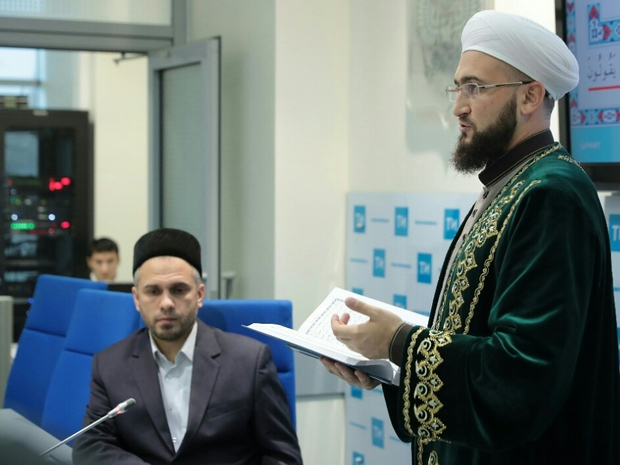
We talked to many people. And, finally, we are holding the book.
The mufti told why the Muslim Spirituality Directorate of Tatarstan got down this task. He said he noted that madrasah students use books printed in Saudi Arabia, Pakistan or Turkey. However, the Tatars have their own edition – Kazan Edition, which is undeservedly ignored by Russian religious people.
'As Muslims, we were the first to prepare an edition of Quran over 100 years ago. And we are proud of it. As people in the East say, 'Quran was sent in Hedjaz, read in Cairo, written in Istanbul but printed in Kazan'.
For example, in Saudi Arabia, the first book of Quran was printed only in 1984. The first machines were delivered to Russia in 1802, and Quran was printed in 1803. The Tatars prepared it for print in Saint Petersburg and Kazan.'
Ottoman standards
According to him, Quran has a sort of standard formed 400 years ago. Pakistan, Saudi Arabia and other countries use it while printing the book. It was created by an Ottoman calligrapher Hâfiz Osman. He offered to end 'ayah' (a sentence) at the end of the page, so that a reader won't have to look for its continuance on the next page, which is quite comfortable while learning by heart.
The 'Tatar Quran' did not use to meet these standards. As a tradition, the Kazan edition was called Kalyam Sharif – 'Noble Word': it became a custom to write it on the front cover of the Holy Book printed in Kazan a long time ago.
The Arab script was specially updated for his edition. The mufti explained 'you won't find it in Word'. Each letter is written separately without joining other signs, which comes very handy for 'beginners'. By the way, letters are frequently written together.
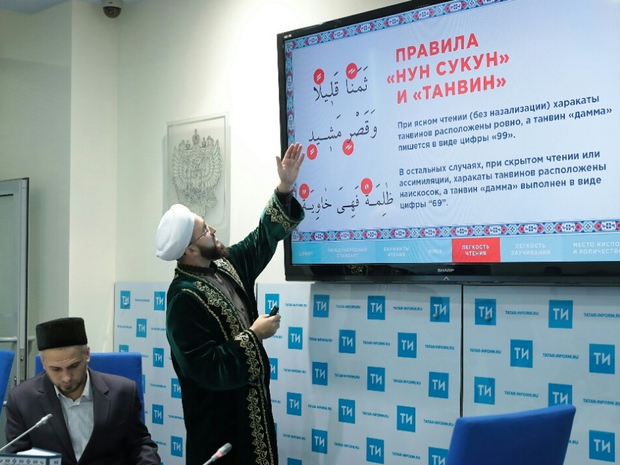
All ḥarakāt are located at one level (in Arabic, all letters are consonants, special signs, diacritics fatḥah, kasrah, ḍammah, maddah play the role of vowels). Vertical strokes show long vowels. And a sign that shows the length of a sound has been added.
In accordance with international standards adopted in the Islamic World, very Quran is divided into 30 parts called a juz'. Each of them contains 20 pages. In turn, each juz' is divided into four sections (hizb). The end of ayah is obligatorily marked with a corresponding sign – a Unicode character that looks like a chamomile. Each page has 15 lines.
Variations in readings of some words – Shatibi and Tayybate an-Nasr – are written in the margin.
Special symbols of tajweed (rules governing pronunciation during recitation of the Quran) have been added: madd, nūn sākinah, tanwīn, hamzah al-wasl, tanwin taksir.
Enumeration of juz' and hizb has been another pleasant novelty. Beginning of a next ayah is written at the bottom of each page, which again significantly simplifies learning. Name of each sura contains information where it was sent to Prophet Muhammad (Mecca or Medina) and the number of verses it has.
The Muslim Spirituality Directorate of Tatarstan published these pecualiarietes in detail and visually on its page.
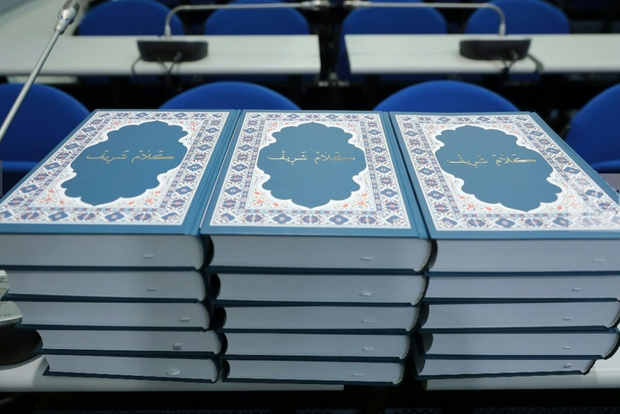
'Tatar Quran' for iOS and Andriod
Kazan Edition has just 5,000 copies. They all will be given to muhtasibats of the MSD of Tatarstan, teachers at madrasah of the republic and imprisoned people who wish to read Quran. The mufti added that having heard about the preparation for the edition of Quran, Dagestan asked 10,000 copies. And they were ready to pay for it immediately.
The Tatarstan Muslims took the new Kazan edition to Hajj and presented it to representatives of the Tatar community in Medina (descendants of the Tatars moved to Saudi Arabia after the Revolution). The Muslim cleric said the Saudi Tatars who forgot their mother tongue a long time ago were unspeakably glad about the present. And they were even ready to repair one of the mosques in their birthplace.
When the correspondent of Realnoe Vremya asked whether this edition would be on sale and how much would it cost, Samigullin found it difficult to answer.
'We are already preparing a new edition, which will have a smaller format. The young prefers to carry things in their bags. In other words, it is an A5 paper. I don't know their price. The Department of Quranic Research is dealing with it, it is completely their work,' Hazrat Kamil told.
The mufti also announced the preparation of Quran for iOS and Android systems. However, the MSD is not going to make a Quran reading pen.
'These pens are made in China. We will have to talk to the Chinese then. But our goal is to teach people to read Quran and live in accordance with it, not make somebody do it instead,' Samigullin emphasised.
What is more, a translation of meanings of Quran in Russian has been prepared for print. A work on modern Tatar translation is in the process.
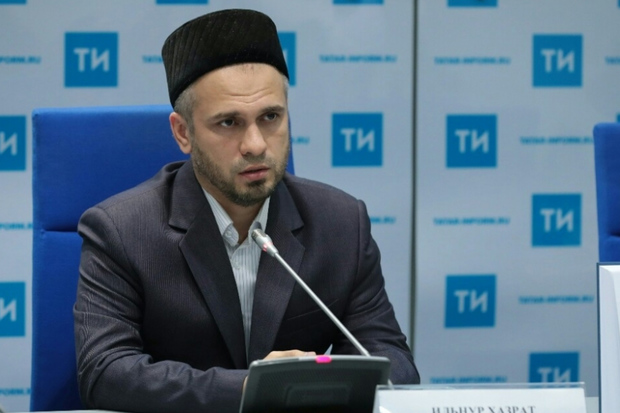
Hajj – the first prize
By the way, as for Hajj and a contest. In turn, the head of the Department of Quranic Research of the MSD of Tatarstan Ilnur Khairullin who was at the press conference told about the upcoming contest of Quran reciters that will have two nominations: Beautiful Recitation of Quran and Quran by Heart.
The first stage will be regional (among muhtasibats) in October. Semi-finals among departments of the muftiate will take place in November. Winners will be known in December. Men will compete at Galeyev Mosque, while women – at Blue Mosque. Winners (four people) will be awarded tickets to Hajj. Runners-up will be presented a trip to Umrah. Valuable prizes will be given to the third place.
Apologies of 'striptease' performer accepted
Realnoe Vremya also asked the mufti to comment the scandal that broke up around a Tatar singer Rezeda Ganiullina who was shot in revealing clothes near the White Mosque in Bolgar. The video of the song found not only opponents but also many supporters.
The imam of Zakabannaya Mosque Seidjgfar Lutfullin who is famous for shocking statements was the first person who paid attention to this video, called her a striptease performer and asked to delete the video during a day.
The girl already apologised to the people who could be insulted for the video.
'We hope she apologised most sincerely. If a person doesn't know something, he or she cannot be accused. We hope the woman did not have a bad will. She did it out of ignorance. People from Moscow reacted, the Muslim Brotherhood was worried. I hope it won't remain on YouTube,' the mufti commented.
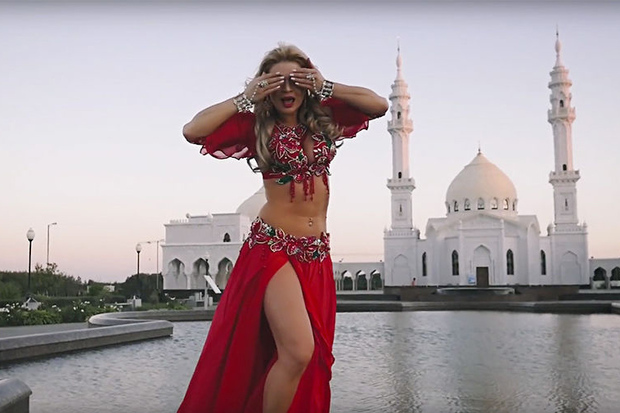
'If a person doesn't know something, he or she cannot be accused. We hope the woman did not have a bad will. She did it out of ignorance.' Photo: vk.com
He says the problem is not that she danced near the temple but that she was shot on the foundation of the old Khan Mosque.
'A mosque remains till the Judgement Day. I did not like the moment where she was dancing around columns. We gather and pray there every year. Although it has not been built completely, it is still a mosque. We accept her apologies, of course. We are glad that the person recognised it. I hope it won't repeat,' Samigullin told Realnoe Vremya.
He also wished to have the moments of the video where the girl dances inside the mosque deleted.
In the evening, the girl promised to delete the video. She kept her promise.